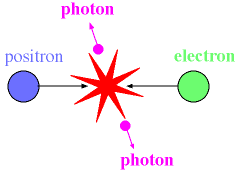Particles and Antiparticles
 In
1928 Dirac developed a quantum theory which included relativity
and predicted the existence of a new particle. This new particle was
the positron which is the
antiparticle of the electron. The positron was predicted to
have the same mass as the electron but carry a positive charge.
In
1928 Dirac developed a quantum theory which included relativity
and predicted the existence of a new particle. This new particle was
the positron which is the
antiparticle of the electron. The positron was predicted to
have the same mass as the electron but carry a positive charge.
Positrons are created simultaneously with electrons to conserve
charge in a process termed pair production. This process has a
threshold energy of 1.022 MeV, because the mass of the positron and
the electron is 0.511 MeV.
If a positron and an electron come near each other, they will
annihilate each other, producing two photons each with energy equal
to the mass of an electron. Thus it is not unusual to observe photons
with exactly the energy of 0.511 MeV that result from the
annihilation of positron/electron pairs at rest. Since photons carry
momentum, the annihilation must produce two photons of equal energy
going in opposite directions to conserve momentum.
In 1954 the antiproton was
discovered by Segre and Chamberlain. The antiproton has the same mass
as a proton but has a negative charge. An antiproton must be produced
together with a proton in order to conserve charge.
In today's modern particle accelerators, beams of antiprotons are
produced and made to collide with counter-rotating beams of protons
in the same accelerator ring. These collisions can be used to study
the fundamental building blocks of nature. Virtually any particle can
have an antiparticle, but the more complex antiparticles are
difficult to create and observe in the laboratory.
A remark on physicist-speak: Above,
we give the mass of the electron as 0.511 MeV. What does this mean?
Well, this is a shortcut that needs explanation:
©
MultiMedia Physics
2000
 In
1928 Dirac developed a quantum theory which included relativity
and predicted the existence of a new particle. This new particle was
the positron which is the
antiparticle of the electron. The positron was predicted to
have the same mass as the electron but carry a positive charge.
In
1928 Dirac developed a quantum theory which included relativity
and predicted the existence of a new particle. This new particle was
the positron which is the
antiparticle of the electron. The positron was predicted to
have the same mass as the electron but carry a positive charge.